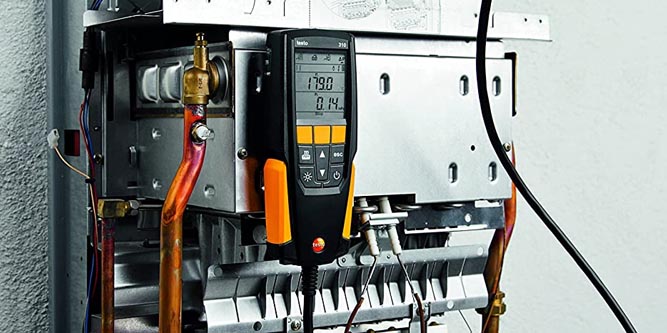Back in the day, boiler tune-ups were a relatively straightforward affair. You adjusted the gas up or down as needed, and you did it by approximation. Is the flame excessively soft and orange? Turn the gas down a bit. Is the flame small and spiky? Turn it up a smidge. If the flame was blue and rounded, everything was working beautifully. That was the most anybody ever did in terms of maximizing the efficiency of a boiler or a furnace.
But time marches on, and there are newer and better ways to improve your efficiency. By using a set of electronic sensors, you can determine how much oxygen and CO2 is leaving the combustion chamber. You can then adjust the fuel with those scientific measurements in mind. That’s a lot better than staring at a flame until it looks “good enough.” This process of reading the combustion chamber’s output is known as combustion analysis. It’s not just important for fuel efficiency, either; it’s also important for safety. Many manufacturer’s warranties will even specifically require regular testing in order for you to maintain coverage.
A modern combustion analyzer is compact, and is designed for handheld use like a multimeter. This makes them an essential part of any technician or inspector’s toolkit. Now, we’re going to review three of the best combustion analyzer test kits that money can buy. First up, we’ll check out the Testo 310. This is a complete test kit, and sports a built-in, easy-to-empty condensate trap. Next, we’ll examine the Bacharach Fyrite Intech.
It comes with internal storage for 10 separate records, along with a printer for recording that information. Last but not least, we’ll look at the Fieldpiece SOX3. This is a more affordable test kit, with a field-replaceable O2 sensor. Which one is the best of the bunch? Let’s dig a little deeper, and find out!
How Does Combustion Analysis Work?
Combustion analysis works because combustion is a predictable, chemical process. After all, combustion is fundamentally just a kind of chemical reaction. Fossil fuels consist of hydrocarbons, or chains of carbon and hydrogen. When this material burns, it reacts with the oxygen in the air. The hydrocarbons and oxygen are turned into carbon dioxide (CO2) and water (H20). In a perfect world, you could use your understanding of this chemical reaction to calculate the ideal fuel-air balance.
Methane is a good example, and it also just happens to be the main component of natural gas. A methane molecule has the chemical name CH4. This means it consists of one carbon atom and four hydrogen atoms. Meanwhile, oxygen in the air consists of O2 molecules, or bonded pairs of individual oxygen atoms. This makes it easy to balance the chemical equation. We can combine two oxygen molecules with one methane molecule to get one molecule of CO2 and two of H20. We also produce heat in the process, which is why we’re going through all this trouble to begin with!
So, an all-methane engine will be most efficient if we let in two molecules of oxygen for every methane molecule. Easy-peasy, right? Not so fast. Getting that kind of performance would require 100 percent efficiency. And 100 percent efficiency is never possible in real life. There are random variables that come into play that will always throw things off. For instance, the fuel and air need time to mix inside the combustion chamber. If the molecules never come into contact, they can’t react! Similarly, there has to be sufficient heat, and enough time in the chamber for combustion to occur.
In practice, this can result in a number of byproducts. If there’s insufficient oxygen in the mix, you can end up with carbon monoxide (CO) or soot (C). The former is hazardous to your health, while the latter is bad for the environment and poses a fire hazard. Too much oxygen can also reduce efficiency, by flooding the combustion chamber with wasted oxygen.
We can determine this by measuring the amount of oxygen, CO2, and CO in exhaust. Ideally, there should be near-zero CO, the maximum amount of CO2, and a little oxygen. A combustion analyzer can detect all of these molecules, and tell you their ratio in the exhaust. Some combustion analyzers can also detect other compounds. For example, many can detect nitrogen oxides from excessive heat, or sulfur dioxide from dirty fuel.
To do this, you simply insert a probe into the flu and sample some of the exhaust gas. During this time, a temperature measurement is also taken, as is a draft measurement. This is a measurement of the difference in air pressure between the inside and outside of the flu. All of these measurements are then put into the analyzer’s on-board computer, which performs a little wizardry. You’ll then get a readout with a variety of information that can be used to fine-tune the combustion.
What do These Readings Mean?
So, how do you interpret these readings? Let’s start with the three most important measurements: O2, CO2, and CO. As we’ve already established, the ideal exhaust gas should contain only water vapor and CO2. It should also contain nitrogen left over from the air. As we’ve already established, there’s an ideal ratio of fuel to air. There’s also a certain amount of extra air that you’re going to need in order to achieve full combustion. This amount of air is called “excess air,” and is usually around 15 percent of the ideal air. The exact ratio will depend somewhat on the design of the boiler or furnace.
As a general rule, there should be no detectable CO in the exhaust. If there is, there’s not enough excess air flowing into the combustion chamber. As you increase the ratio of oxygen to fuel, you’ll notice a steep drop-off in the quantity of CO. This will be accompanied by a proportional rise in CO2 concentration. After CO has disappeared, the amount of CO2 will continue to increase to a certain point. If more oxygen is added beyond that point, the amount of CO2 will decrease. If you want maximum efficiency, you want to be producing the maximum amount of CO2. The exact maximum will depend on the type of fuel you’re burning.
Certain combustion analyzers can also sense common pollutants. Among the most common of these are the nitrogen oxides, NO and NO2. These gasses contribute to smog, acid rain, and ground-level ozone. They’re always present in small amounts but high concentrations indicate that the combustion chamber is too hot. Some analyzer test kits can also detect sulfur dioxide (SO2). SO2 has the same harmful effects as NO and NO2. However, it’s easily eliminated by using low-sulfur or de-sulfurized fuels.
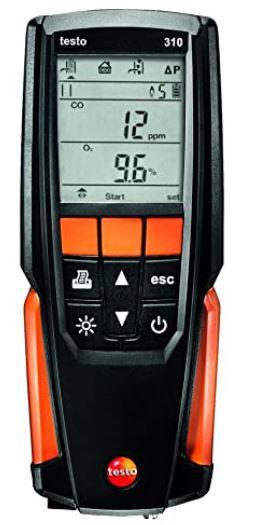
Testo 310
The Testo 310 is a mid-sized combustion analyzer that comes with everything you need to get started. To begin with, you get a pistol-style probe, which connects to the bottom of the housing via a short hose. This is equipped with a nose cone that gives very accurate readings. However, the cone can be removed to reveal a smaller inner probe that can be inserted through small holes. There are two extra hoses in case the cable gets damaged. There are even 10 extra particulate filters, and a nifty hard case for keeping everything organized.
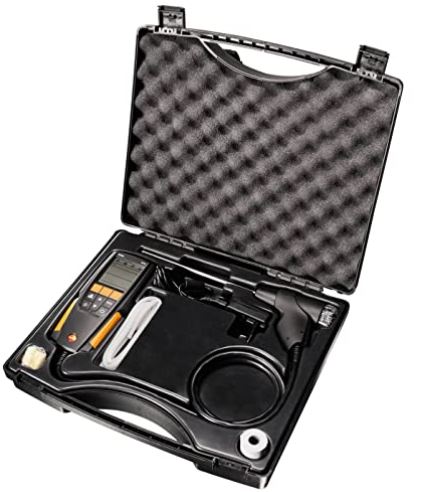
The analyzer housing is made of black plastic, with high-visibility orange hand grips. The back features built-in magnets for easy mounting on ducts and other machinery. This allows you to work with one hand instead of two. The display is backlit, allowing for good visibility in both light and dark conditions. It can measure temperature, draft, and the amount of O2, C02, and CO in the exhaust. You can cycle through these readings with a pair of arrow buttons, which makes operation fairly simple. Additional contextual menu keys allow you to perform additional functions. There’s even a print button, although no printer is included with the kit.
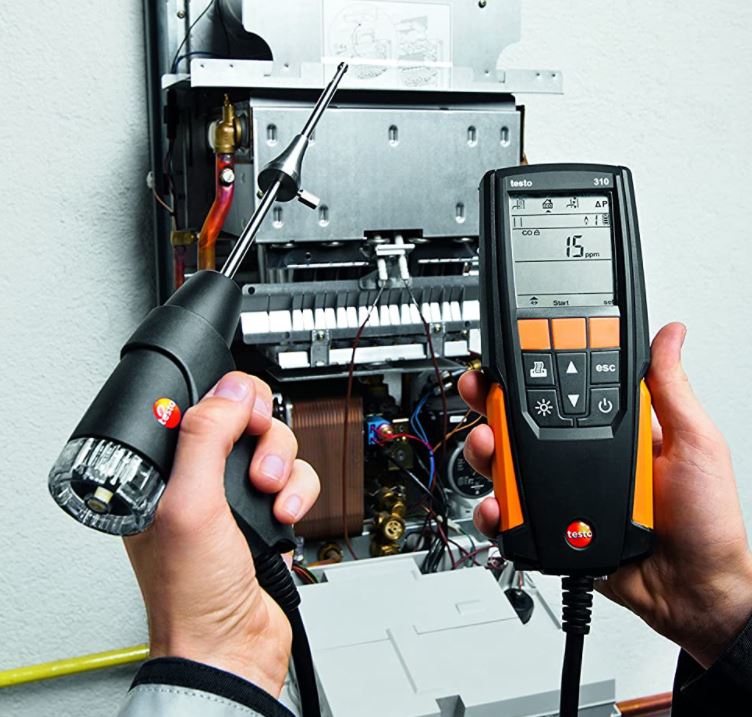
The front of the unit has a small slit that opens to an inner condensate trap. To drain condensed moisture, you simply need to tilt the analyzer forward. Any water will simply dribble out of the housing.
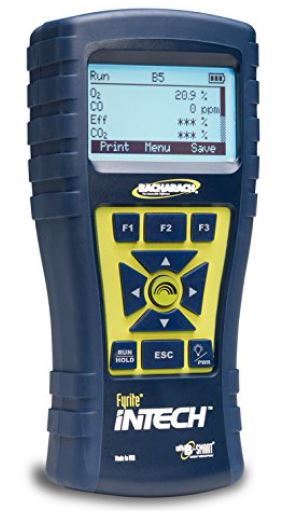
Bacharach Fyrite Intech
The Bacharach Fyrite Intech is a more robust combustion analyzer that’s designed for residential furnaces. In addition to all the same readings as the Testo analyzer, it also has a fuel type menu. You can choose between the six most common residential fuels, and find ideal measurements for each of them. Admittedly, this is something you could find on a chart. But having everything automated is just so much easier. Like the Testo, the Fyrite Intech has a backlit LCD display, so you can read it just fine in a dark basement.
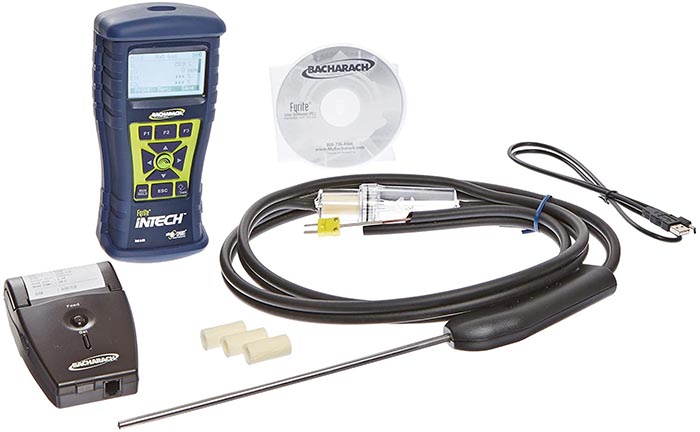
The on-board storage allows you to save 10 complete records, including all measurements. If you need a more concrete record, you can use the included printer to create a physical copy. Other accessories include all the required cables, three particulate filters, and a rugged hard case.
In addition to all this, the Fyrite Intech utilizes B-Smart replaceable sensors. These are pre-calibrated, and can be swapped out in the field. This means you don’t have to send the analyzer in to the manufacturer for re-calibration. Moreover, replacement sensors are actually cheaper than manufacturer recalibration. By using pre-calibrated replacements, you’re saving time and money at the same time.
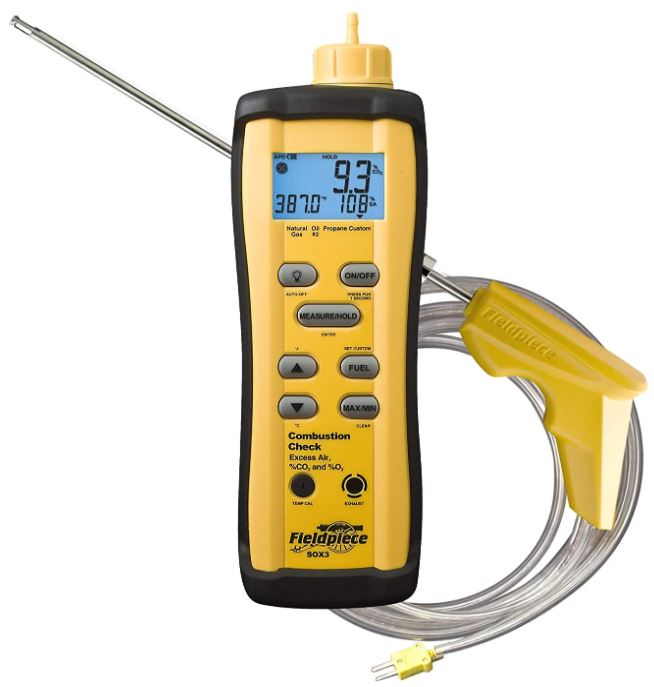
Fieldpiece SOX3
Fieldpiece is a well-known manufacturer that specializes in testing equipment. Among other tools, they produce some high-quality digital manometers. The Fieldpiece SOX3 is made to be as affordable as possible. This means you get an analyzer and probe only. There’s no fancy carrying case, and no extra parts and pieces. That said, the probe and analyzer themselves are well designed, so you’re getting good value for your money.
The SOX3 measures the percentage of O2 and CO2 in the exhaust. It also measures the flue temperature, the percentage of excess air, and the combustion efficiency. That said, there’s a major limitation in its design; it doesn’t measure CO concentration. You can use it to ensure maximum CO2 production, which means your CO production should be near zero. But that’s only true in theory. In reality, funky air patterns can cause incomplete combustion in parts of the furnace. If that’s the case, you’d really like to know that your furnace is putting out carbon monoxide. Unfortunately, the SOX3 won’t tell you.
One useful feature the SOX3 shares with the Fyrite Intech is that the O2 sensor is replaceable. It even has a built-in sensor that tells you when it needs to be replaced.
Final Verdict
So, which combustion analyzer is the best? In most respects, it’s going to depend on what you need. The Testo 310 is a great choice for homeowners and professionals who need to perform basic readings. It gives you a reading of CO2, CO, O2, temperature, and draft, which are the most important readings. Not only that, but the nose cone is particularly well designed. It will cover a mid-sized access hole, providing a better reading. But since it’s removable, you can also work through smaller holes. The only downside is that you can’t get advanced readings like nitrogen oxide and sulfur dioxide.
The Bacharach Fyrite Intech was the priciest of the three offerings, but also the most full-featured. It includes a printer, so you can easily make physical records of your work. There’s also on-board storage for ten readings, as well as profiles for six common heating fuels. In addition to that, this analyzer is just plain well-designed, with replaceable sensors that keep downtime to a minimum.
The Fieldpiece SOX3 is the best choice if you only need basic functionality and don’t want to spend a ton. It’s a barebones probe and analyzer that measures the temperature, and the CO2 and O2 concentrations. That’s enough to maximize furnace or boiler efficiency, which is a good starting point. This is a solid choice for homeowners, but HVAC professionals will want something with more features.
Meet Ry, “TechGuru,” a 36-year-old technology enthusiast with a deep passion for tech innovations. With extensive experience, he specializes in gaming hardware and software, and has expertise in gadgets, custom PCs, and audio.
Besides writing about tech and reviewing new products, he enjoys traveling, hiking, and photography. Committed to keeping up with the latest industry trends, he aims to guide readers in making informed tech decisions.

